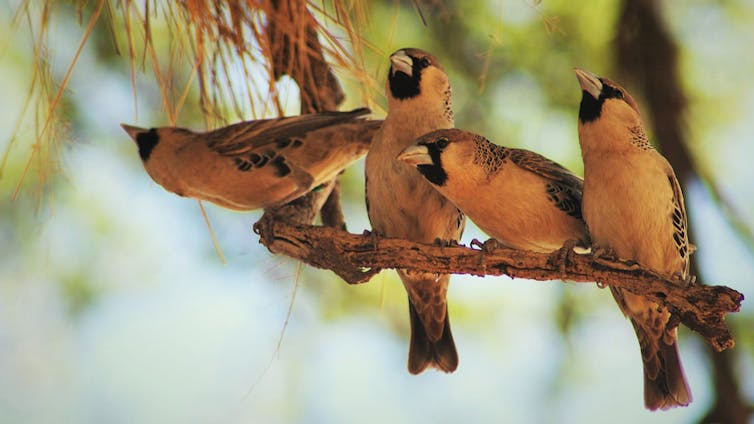How can animals, from ants to people, form social groups with individuals working successfully together for a common good?
So Charles Darwin asked in 1859, perceiving the existence of cooperative behaviour as a threat to his theory of evolution. Such behaviour remains one of the biggest unanswered questions in science – one that our study, published in Ecology Letters, set out to answer with the help of a highly social bird, the sociable weaver.
It’s easy to see why animals should behave selfishly: if you are to pass on your genes to the next generation you should aim to look after yourself, protect your resources, find a mate and reproduce – why would you care about others? As a result of such selfish interests conflict is rife in nature. But what is less well known is that cooperation is also widespread and can be observed at almost any level of biological organisation.
There has been much progress since Darwin, and we now understand a great deal more about how animals may benefit from working together. Although several important theories have been developed and tested over the past decades, kin selection theory has perhaps caused the greatest advance in our understanding of cooperation in animals. Introduced by Bill Hamilton in the 1960s it states that if an individual cooperates with its relatives, this individual may indirectly pass on its genes to the next generation. This is now generally accepted as the main explanation behind cooperation at the family level.
Cooperation, however, can be observed at a much larger scale, with large social groups working successfully together to construct and maintain a common good outside the context of breeding. How kin selection might promote such large social groups is much less straightforward, due to the usually low average levels of relatedness and the social dilemmas faced by individuals within those group. A well-known and widespread social dilemma is a phenomenon called the tragedy of the commons.
Under the tragedy of the commons, social benefits are highest in groups that cooperate, but selfish individuals do better within cooperative groups. If selfishness prevailed, public goods would become over-exploited and society would collapse. Examples from human society include over-exploitation of fish stocks, our failure to efficiently deal with climate change, and the collapse of the society of the original inhabitants of Easter Island. How do animals avoid such collapse and manage to keep freeloaders at bay?

Simulating society with songbirds
To find out, our research team at the University of Sheffield, led by Professor Ben Hatchwell, turned to sociable weavers (Philetairus socius) as a model system. This small passerine bird is extremely social and builds the largest nest of any bird – communally housing hundreds of individuals, weighing more than a tonne, and lasting for decades.
Their massive nest consists of individual nest chambers embedded within a communal thatch. The latter requires separate investment from the colony members and does not emerge from investment in the individual nest chambers. By studying the thatch we can investigate how the birds work together to maintain their public good.
After detailed observations of their behaviour and tests to reveal the genetic relationships among the colony members, we found the birds contributing to thatch building did so above their own nest chamber. This indicates self-directed thatch building.
However, we also found that these thatchers’ neighbours were often relatives, and that as they also benefited this suggests the thatch-building might be directed towards kin. In trying to corroborate that idea, we found that relatedness to near neighbours predicted thatch building: the more related an individual is to its neighbours, the more likely it is to contribute to the communal good.
Finally, we found related individuals tend to share the use of nest chambers and thus share the benefits of their communal investment among relatives. So these sociable birds benefit from having good neighbours, and from maintaining healthy family relationships – a lesson to us all, no doubt. Despite low relatedness at colony level, social organisation of relatives within the colony leads to communal investment being enjoyed by relatives, as well as contributing to the overall thatch important for the nest as a whole.
This is the first study to show that kin selection may encourage the animal effort required to communally build and maintain a structure, and as such it may be relevant to the many other species that build some sort of structure. However, for that most cooperative of species, humans, the mechanism our study revealed is unlikely to apply directly.
Other solutions to the problem of cooperation exist, such as the enforcement of laws and agreements. Perhaps it is these we must turn to – the enforcement of sustainable fishing practices, for example – to ensure the tragedy of the commons is not replicated on a global scale.

